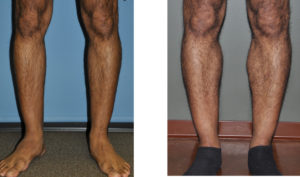Calf augmentation is most commonly done with implants. There are a variety of reasons patients pursue augmenting the gastrocnemius muscle from congenitally thin legs, muscle atrophy due to disease or trauma and the desire for larger calfs that exercise and effort alone can not easily achieve.

But despite the success of calf augmentation with proper surgical technique, it is not commonly performed by most plastic surgeons. This is undoubtably because it is infrequently requested and, as a result, it is very hard for a surgeon to develop much experience with this type of body implant surgery.
In the October 2017 issue of the Aesthetic Surgery Journal, an article entitled ‘Calf Augmentation and Restoration: Long-Term Results and the Review of the Reported Complications’. The authors reviewed their 25 year experience with calf implant augmentation in 50 patients. (60 calfs) Indications were aesthetic in 23 patients, six were bodybuilders, and 21 underwent lower leg reconstruction because of deformity caused by illness. Their results based on surgeon evaluation had good to excellent results obtained in 30 out of 37 implanted patients. (81%) Patients rated their results as acceptable to good in 35 out of 37 patients. One very serious complication occurred in a bodybuilder who developed compartment syndrome in one leg leading to the necrosis of muscles. The authors report other complications as minor and manageable.
This series of calf implants shows that it can be a successful and low complication body contouring procedure. From a medical complication standpoint, infection is always a risk with an implant but that appears to be fairly low in a pocket that is partially lined may muscle. The devastating complication of compartment syndrome has rarely been reported but it is easy to see how it is possible…the use of four implants (two in each leg, medial and lateral muscle bellies) on top of already large calf muscles. This can potentially impair arterial inflow and one must always be on guard for its prevention.
Dr. Barry Eppley
Indianapolis, Indiana


